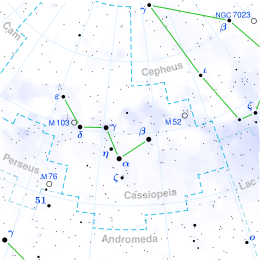HD 19275
| Observation data Epoch J2000.0 Equinox J2000.0 | |
|---|---|
| Constellation | Cassiopeia |
| Right ascension | 03h 11m 56.27016s[1] |
| Declination | +74° 23′ 37.1670″[1] |
| Apparent magnitude (V) | 4.85[2] |
| Characteristics | |
| Spectral type | A2Vnn[3] |
| U−B color index | +0.05 |
| B−V color index | +0.035±0.006[2] |
| Astrometry | |
| Radial velocity (Rv) | 11.9±3.1[2] km/s |
| Proper motion (μ) | RA: +13.895[1] mas/yr Dec.: −86.650[1] mas/yr |
| Parallax (π) | 19.9554 ± 0.1695[1] mas |
| Distance | 163 ± 1 ly (50.1 ± 0.4 pc) |
| Absolute magnitude (MV) | 1.32[2] |
| Details | |
| Mass | 1.80+0.32 −0.29[4] M☉ |
| Radius | 2.7[5] R☉ |
| Luminosity | 27.27[2] L☉ |
| Surface gravity (log g) | 4.20±0.25[4] cgs |
| Temperature | 8,875±1,000[4] K |
| Metallicity [Fe/H] | −0.11±0.26[6] dex |
| Rotational velocity (v sin i) | 250[7] km/s |
| Age | 71+317 −60[4] Gyr |
| Other designations | |
| Database references | |
| SIMBAD | data |
HD 19275 is a single[9] star in the northern constellation of Cassiopeia. It has a white hue and is faintly visible to the naked eye with an apparent visual magnitude of 4.85.[2] The distance to HD 19275 is 163 light years as determined using parallax measurements.[1] It is drifting further away from the Sun with a radial velocity of around 12 km/s.[2]
This object is an A-type main-sequence star with a stellar classification of A2Vnn.[3] The 'nn' suffix indicates "nebulous" (broad) absorption lines in the spectrum due to rapid rotation. It is spinning with a projected rotational velocity of 250 km/s, which is giving the star an equatorial bulge that is estimated to be 15% larger than the polar radius.[7] The object is an estimated 71[4] million years old with 1.8[4] times the mass of the Sun and about 2.7[5] times the Sun's radius. It is radiating 27[2] times the luminosity of the Sun from its photosphere at an effective temperature of 8,875 K.[4]
References[]
- ^ a b c d e f Brown, A. G. A.; et al. (Gaia collaboration) (August 2018). "Gaia Data Release 2: Summary of the contents and survey properties". Astronomy & Astrophysics. 616. A1. arXiv:1804.09365. Bibcode:2018A&A...616A...1G. doi:10.1051/0004-6361/201833051. Gaia DR2 record for this source at VizieR.
- ^ a b c d e f g h Anderson, E.; Francis, Ch. (2012), "XHIP: An extended hipparcos compilation", Astronomy Letters, 38 (5): 331, arXiv:1108.4971, Bibcode:2012AstL...38..331A, doi:10.1134/S1063773712050015, S2CID 119257644.
- ^ a b Cowley, A.; et al. (April 1969), "A study of the bright A stars. I. A catalogue of spectral classifications", Astronomical Journal, 74: 375–406, Bibcode:1969AJ.....74..375C, doi:10.1086/110819.
- ^ a b c d e f g Gullikson, Kevin; et al. (2016), "The Close Companion Mass-ratio Distribution of Intermediate-mass Stars", The Astronomical Journal, 152 (2): 40, arXiv:1604.06456, Bibcode:2016AJ....152...40G, doi:10.3847/0004-6256/152/2/40, S2CID 119179065.
- ^ a b Pasinetti Fracassini, L. E.; et al. (2001), "Catalogue of Apparent Diameters and Absolute Radii of Stars (CADARS)", Astronomy & Astrophysics (Third ed.), 367 (2): 521–24, arXiv:astro-ph/0012289, Bibcode:2001A&A...367..521P, doi:10.1051/0004-6361:20000451, S2CID 425754.
- ^ Gáspár, András; et al. (2016), "The Correlation between Metallicity and Debris Disk Mass", The Astrophysical Journal, 826 (2): 171, arXiv:1604.07403, Bibcode:2016ApJ...826..171G, doi:10.3847/0004-637X/826/2/171, S2CID 119241004.
- ^ a b van Belle, Gerard T. (March 2012), "Interferometric observations of rapidly rotating stars", The Astronomy and Astrophysics Review, 20 (1): 51, arXiv:1204.2572, Bibcode:2012A&ARv..20...51V, doi:10.1007/s00159-012-0051-2, S2CID 119273474.
- ^ "HD 19275". SIMBAD. Centre de données astronomiques de Strasbourg. Retrieved 2019-12-16.
- ^ Eggleton, P. P.; Tokovinin, A. A. (September 2008), "A catalogue of multiplicity among bright stellar systems", Monthly Notices of the Royal Astronomical Society, 389 (2): 869–879, arXiv:0806.2878, Bibcode:2008MNRAS.389..869E, doi:10.1111/j.1365-2966.2008.13596.x, S2CID 14878976.
- A-type main-sequence stars
- Cassiopeia (constellation)
- Durchmusterung objects
- Henry Draper Catalogue objects
- Hipparcos objects
- HR objects
